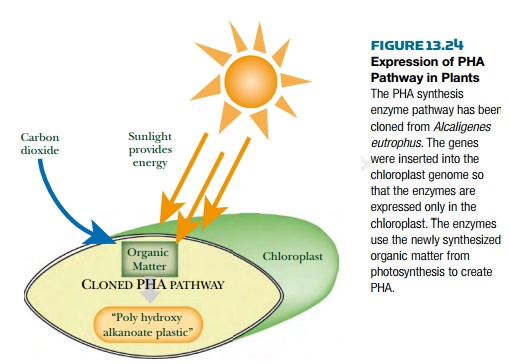Chapter: Biotechnology Applying the Genetic Revolution: Pathway Engineering
Biosynthetic Plastics Are Also Biodegradable
BIOSYNTHETIC
PLASTICS ARE ALSO BIODEGRADABLE
Plastics are polymers built
from chains of monomer subunits, like proteins and nucleic acids. However, most
plastics consist of the same monomer mindlessly repeated over and over again.
Sometimes two or more closely related monomers may be mixed together and follow
each other at random.

Certain bacteria make and
store a group of related plastics known as polyhydroxyalkanoates
(PHAs). Their composition is shown in Fig. 13.23. The bacteria accumulate
PHAs when they have surplus carbon and energy but are running low on other
essential nutrients, such as nitrogen or phosphorus. When conditions improve,
the PHA is broken down and used as a source of energy. The most commonly found
PHA has four-carbon (hydroxybutyrate, HB) subunits and is therefore called polyhydroxybutyrate (PHB). However, a
plastic made by randomly mixing in
10% to 20% of five-carbon (hydroxyvalerate, HV) subunits has much better
physical properties. Still other PHAs containing a proportion of subunits that
are eight-carbon or longer give materials that are more rubbery.
A poly-HB/HV copolymer is
manufactured by mutant bacteria of the species Alcaligenes eutrophus and is marketed by the Zeneca Corporation
(United Kingdom) under the trade name of Biopol. It is more expensive than
plastics made from oil, but it is completely biodegradable. Consequently, PHAs
are restricted at present to specialized uses. For example, because they break
down slowly inside the body to give natural, biochemical intermediates, they
can be used for making slow-release capsules.

To make PHAs economically
competitive, they will need to be produced cheaply and in bulk. One possible
way to do this is to insert the genes for their synthesis into suitable crop Chloroplast plants. This is still in the
experimental stage, but the genes for making PHA from Alcaligenes eutrophus have been successfully inserted into Arabidopsis, a plant widely used for
genetic experiments. The engineered PHA genes were designed to be expressed
inside the chloroplasts of the plant (Fig. 13.24). Because chloroplasts are the
sites of photosynthesis, newly synthesized organic matter appears here first.
Locating the PHA pathway in chloroplasts, rather than in the main compartment
of the plant cells, gives a 100-fold increase in PHA yield. The next step will
be to move the pathway into a genuine crop plant such as rapeseed or soybeans.
Perhaps this will give new meaning to the phrase “plastic flowers”!
Related Topics